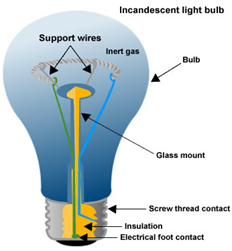Till now we have been considering charges at rest. Now we will learn about the charges in motion. When electric charges are moving across any surface, we say that an electric current is flowing through that surface.
Electric charges are of two kinds positive and negative. So, electric current is produced due to the flow of negative charge or positive charge or both kinds of charges. In metals, the current is produced only due to the flow of free electrons i.e., negative charge. In case of electrolyte its molecules are dissociated among positive and negative ions in solution. Thus, the current in electrolyte is due to the flow of both positive and negative charges.
The rate of flow of electric charge through any cross-sectional area is called electric current. If the charge Q is passing through an area A in time t second (fig. 16.1), then the current flowing it will be I, whereas
I= Q/t ……………………… (16.1)
In system international, the unit of current is known as ampere.

Conventional current
Suppose a stream of positively charged particles is being injected in a metal cup (fig. 16.2).
We will say that an electric current is flowing through the upper cross-section of the cup. As due to this current the amount of positive charge is increasing in the cup, so electric current is flowing into the dup. this current is due to motion of the positive charge and its direction is the same as that of the motion of the positive charges.
If we now stop injecting positive charges and instead inject a beam of electrons into the cup, then the quantity of positive charges stored in the cup would start neutralizing due to which the quantity of charge in the cup would decrease and it would so seem to us that a current of positive charge is flowing out of the cup. Thus, the effect of flow of current due to negative charge is the same as that of the current due to an equal amount of positive charge flowing in opposite direction.
As electric current is measured by the effect which it produces therefore we can say that a current produced due to flow of negative charges is equivalent to a current due to flow of an equal amount of positive charge is known as conventional current substituted by its equivalent positive charge conventional current flowing in opposite direction and we can assume that electric current is always due to flow of positive charges.

Now let us see how a current flows in a conductor. Consider a conductor in the form of a copper wire. It has a large number of free electrons which are in random motion just like the molecules of a gas confined in a container. Their movement does not obey any symmetry but they move in all directions (fig. 16.3).
In the absence of an electric field the rate at which the free electrons cross any section of the wire from right to left is equal to the rate at which they cross from left to right with the result that the net rate is zero. So in spite of the fact that electrons are in motion, no current flows through any section of the conductor. Now if one end of the copper wire is connected with the positive terminal of a battery and the other with its negative terminal, an electric field E is establish at each point of the wire (fig. 16.4).
Now the free electrons, because of their negative charge, experience a force in a direction opposite to the direction of electric field E. because of this force a net directed flow of free electron takes place from the negative terminal of the battery towards its positive terminal and an electric current begins to flow through the wire from the positive terminal towards the negative terminal of the battery. Note that the current flow due to negative charges has been changed with conventional current. This current flows in the wire from positive to negative terminal of the battery i.e., current flow from a point of higher potential to a point of flower potential.
Example 16.1:
If 0.5C charge passes through a certain surface in 10s, then find the current flowing this surface.